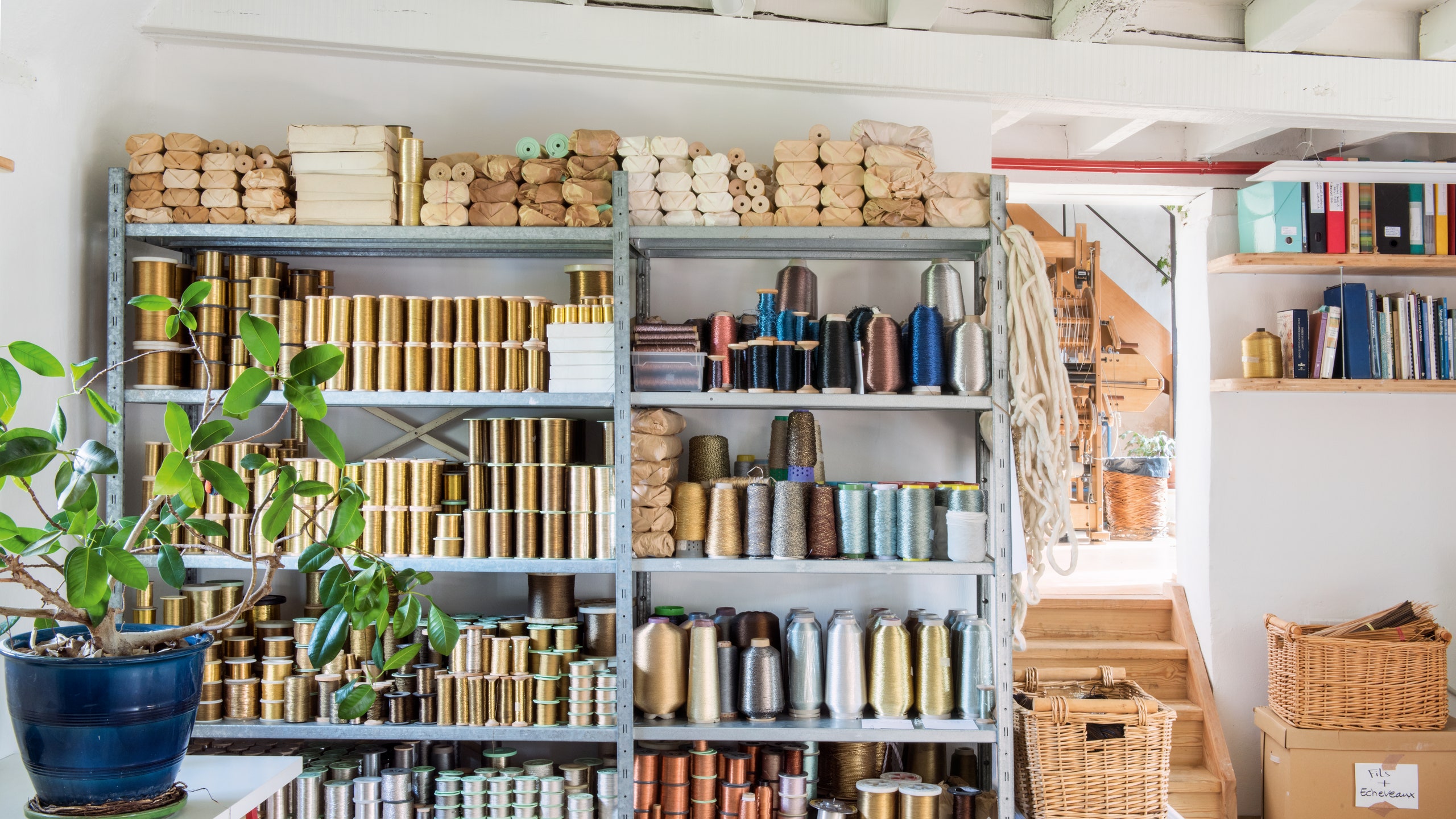No-one loves gold like Anne Corbière. In her sixties and full of youthful, balletic charm as she pops out to feed her ducks in between weaving sessions, she is the first to admit it: ‘For me, this colour evokes all that is rare, precious, even religious. It communicates a certain spirituality.’ Originally commissioned by interior designer Peter Marino to cover the walls of several Chanel stores in a sort of dark gold tweed, recalling the fashion house’s iconic suit, Corbière is currently working on a series of panels for the brand in Shanghai.
It’s part of a broader project creating gilded panels and cushions for the company across Asia, notably a huge dégradé screen inspired by the works of Joan Mitchell. But she is not limited to spinning gold, with private commissions ranging from celadon- and ivory-coloured curtains in Venice to, most lately, a dining room in New York lined with wooden panels framing green woven fabric.
Corbière was born in the state of Oregon into a cultured family. Her father, an avid music- and theatre-lover, took the family on a tour of Europe during his sabbatical year; ‘It changed my life,’ says Anne. She now lives with her husband in a remote hamlet in Anjou, not far from the Angers Apocalypse Tapestry, a jewel of Medieval art. This rural patchwork of cows, rivers and hedgerows is where she finds her inspiration and works on her pieces alongside her two assistants. In Oregon, she studied French literature, film and the history of fashion before moving to Europe. It was in London that she met her future husband, sculptor and furniture designer Vincent Corbière, an instrument-maker at the time. ‘When I came to Europe, I was fascinated by all the craftsmanship there was to discover.
In Oregon, it all began in 1920 – although some of my ancestors were weavers.’ In the 1980s, the couple moved to France, where Anne worked on Peter Brook’s production of The Mahabharata. Under the watchful eye of costume designer Chloé Obolensky, she learned the techniques of fabric-dyeing and painting. Ever the perfectionist, she then enrolled for another year of study at the Ecole Nationale Supérieure de Création Industrielle.
Here, she met Christian Lacroix and was blown away by his unfettered use of colour. She went on to work with him for ten years while also collaborating with Dior, Balenciaga, McQueen, Ghesquière, Givenchy and even Li Edelkoort. In the 1990s, Pierre Passebon inaugurated her into the world of decoration after she offered him a stool she had made with her husband. ‘She had woven paper with gold thread,’ he explains. ‘It was simultaneously sophisticated, inventive and perfectly suited to interior design.’ Anne proceeded to work with the likes of Jacques Grange and Muriel Brandolini.
In partnership with Chahan Minassian, she produced designs for the Hôtel de Crillon and blinds for the new Tiffany store in New York. ‘All of this really changed my perspective. In the fashion industry, I was placing my fabrics on skin, so I was looking at everything really closely. With interior design, I’m learning to step back and appreciate things from a distance.’ Leaving her loom and her obscure hamlet, she’s continually flying her samples to all the international showrooms, from New York to Los Angeles, London and Paris, where she now teaches every month at the Institut Français de la Mode. But Anne remains very invested in her local community too, and runs textile design classes at the village school back in Anjou. At her workshop, her two assistants go home every evening by bike, and budding practitioners – from Angers and as far afield as Beirut – are routinely invited to take up a maker’s residence. For this seasoned innovator, every day begins with just two threads: the warp and the weft.
What may seem simple at first glance gives rise to sometimes dizzying choices. The combination of these two threads can give us wool, silk, flannel, tweed, muslin or chintz, not to mention the fabrics invented by Anne herself. Should she perhaps experiment with this heated, stretched strand of metal, like a spider spinning its thread, before pairing it with, say, wool or cotton? In Lyon, Anne bought spool upon spool of 1950s silk; in Saint-Etienne, she discovered a soft, coloured chenille and a rare polyester. Inspired by the native peoples of her home country, she shreds old T-shirts and jeans to make thin strips that she then weaves with paper, bamboo and other recovered materials.
A visit to the flea market or the Marché Saint-Pierre fabric shop can send her back to the drawing board. That’s just how she got the idea for her sumptuous matt gold ‘skins’. ‘Originally I wanted to go for a polycotton interwoven with brass wire and a rusted silver that I came across in Ardèche,’ she explains. ‘I had made a little folding screen for Passebon and Karl Lagerfeld noticed it. We tried it out on some chairs and he said, “It would be good to have an entire room like that!”’ But it was Marino who would realise that idea later for Chanel.
‘Yes, I like the constantly changing nature of gold as a material, but it’s about much more than its value for me,’ Anne explains. ‘What I love is talking to the people who make these threads, and finding new combinations and materials. The beauty of imperfection is something that’s very important to me: the traces of the human touch in something handmade can entirely change an atmosphere – especially in these very controlled spaces that sometimes really need it.’
Anne Corbière. Visit annecorbieretextiles.com
A version of this article appears in the April 2024 issue of The World of Interiors. Learn about our subscription offers
